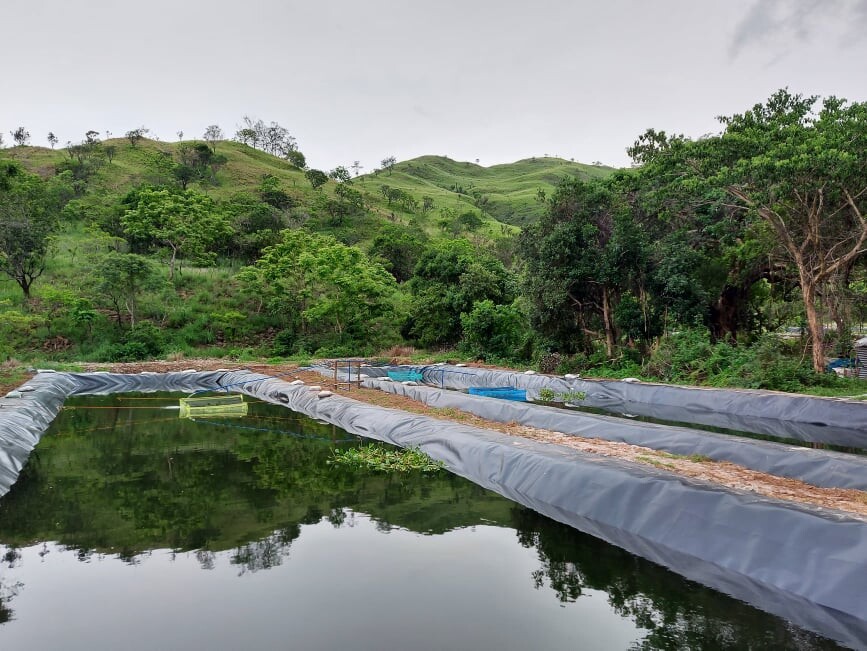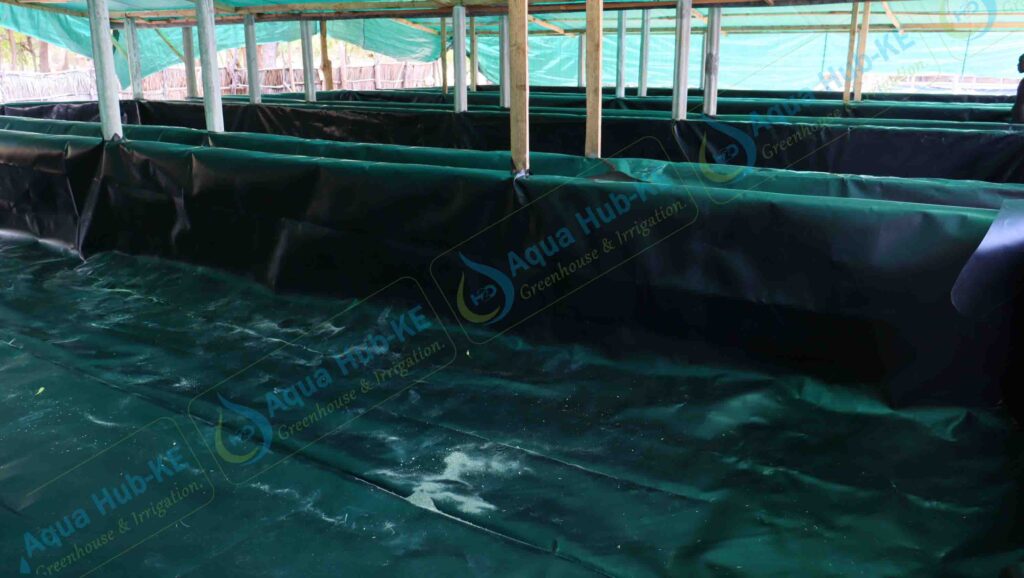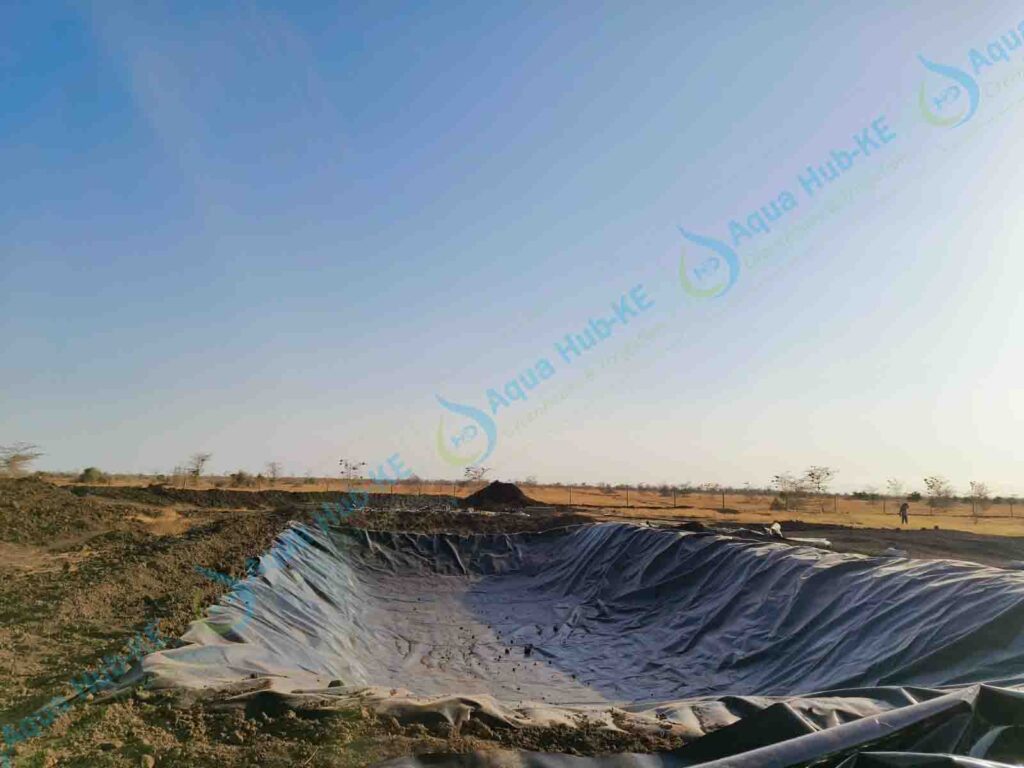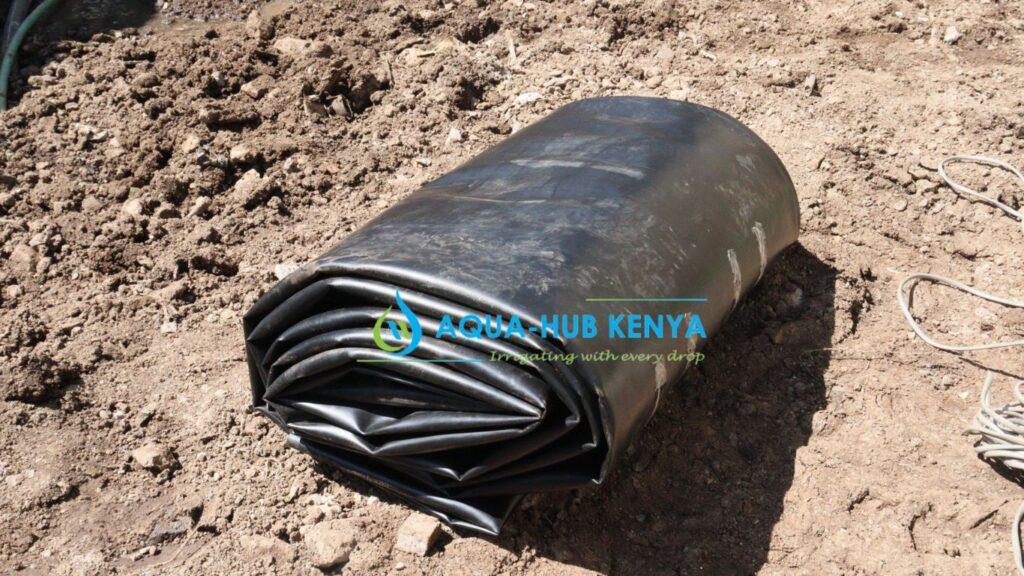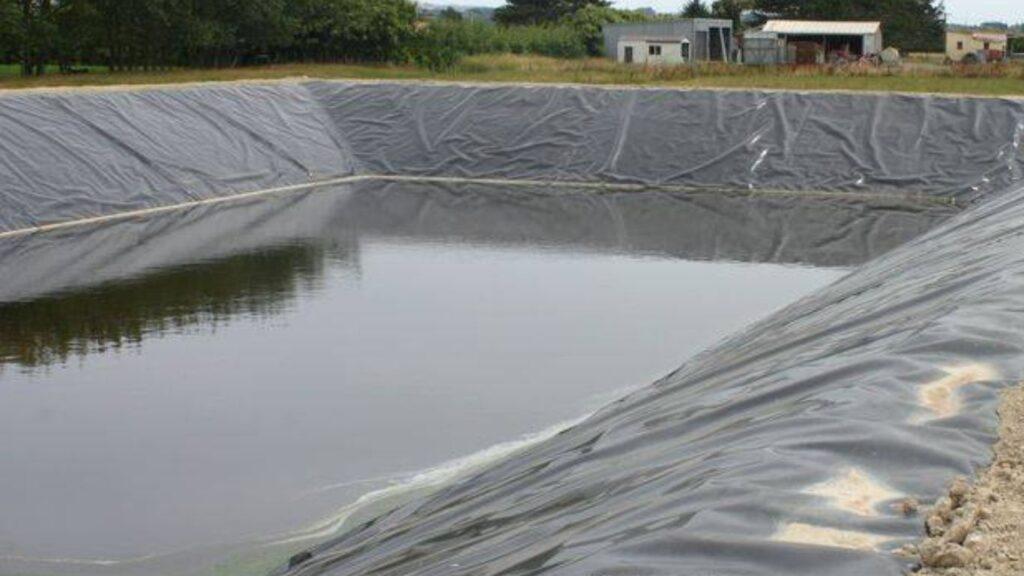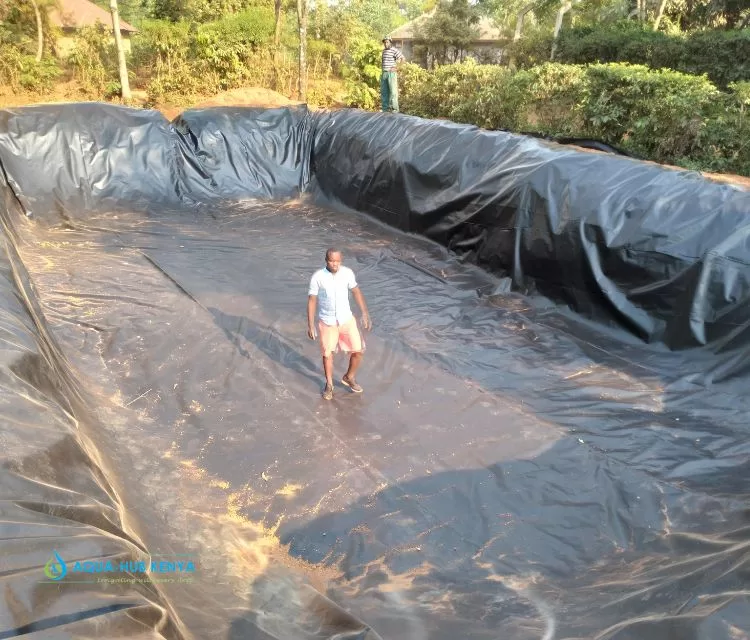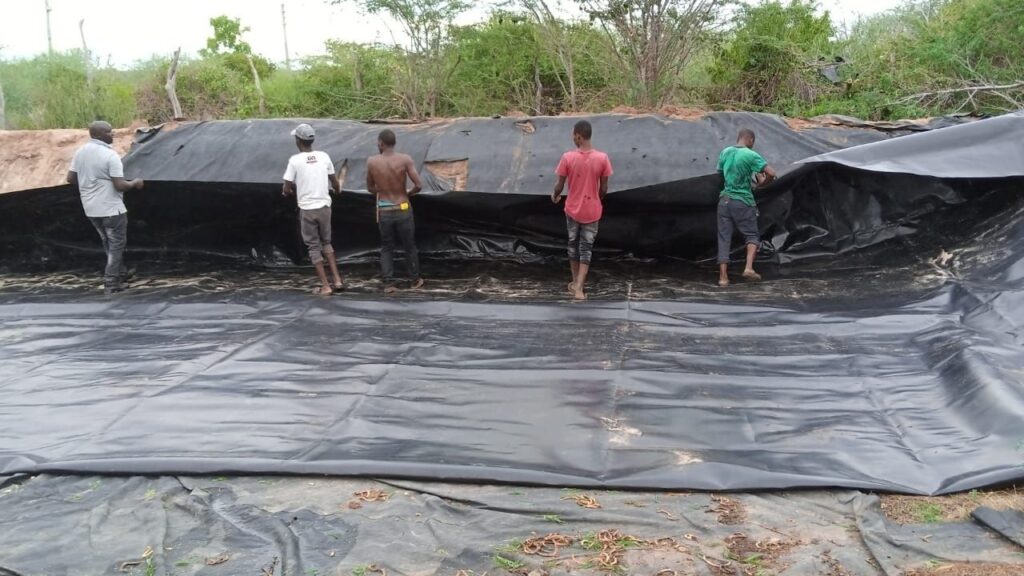Blog
Fishpond Liner Price in Kenya
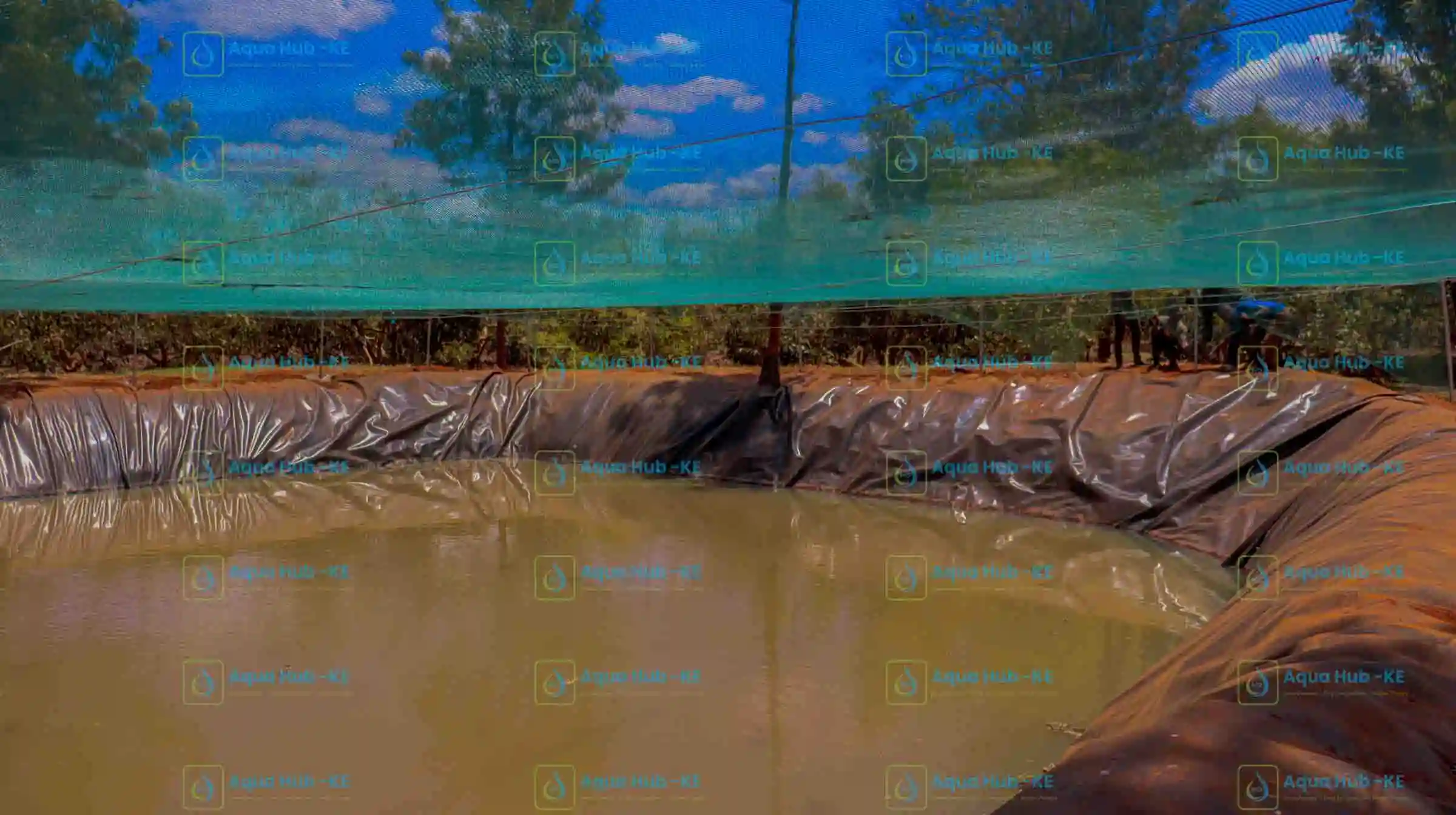
For individuals who are interested in starting fish farming, the challenge is water access and retention. Fish farming is done in ponds which are often limited to aread with clay or high-water retentive soil structures. However, with the use of fishpond liner available at low price in Kenya, water stays put and you can rear fish. This breaks down the cost of fishpond liners, categories, sizes, practical uses and the reliable stockist in Kenya.
Our fishpond liner price are between KES 200 to KES 450 per square meter depending on the thickness size.
Call 0790719020
Pond Liners in Kenya
A pond liner is a sheet of impermeable material that you install on the base and sides of a pond (or dam or water pan) to prevent water loss through seepage. In Kenya many small-scale farmers and fish‐farmers face challenges of water shortage and unpredictable rainfall. Fishpond liners enhance reliable water supply for fish, irrigation, or water harvesting.
Fishpond Liner for Sale in Kenya
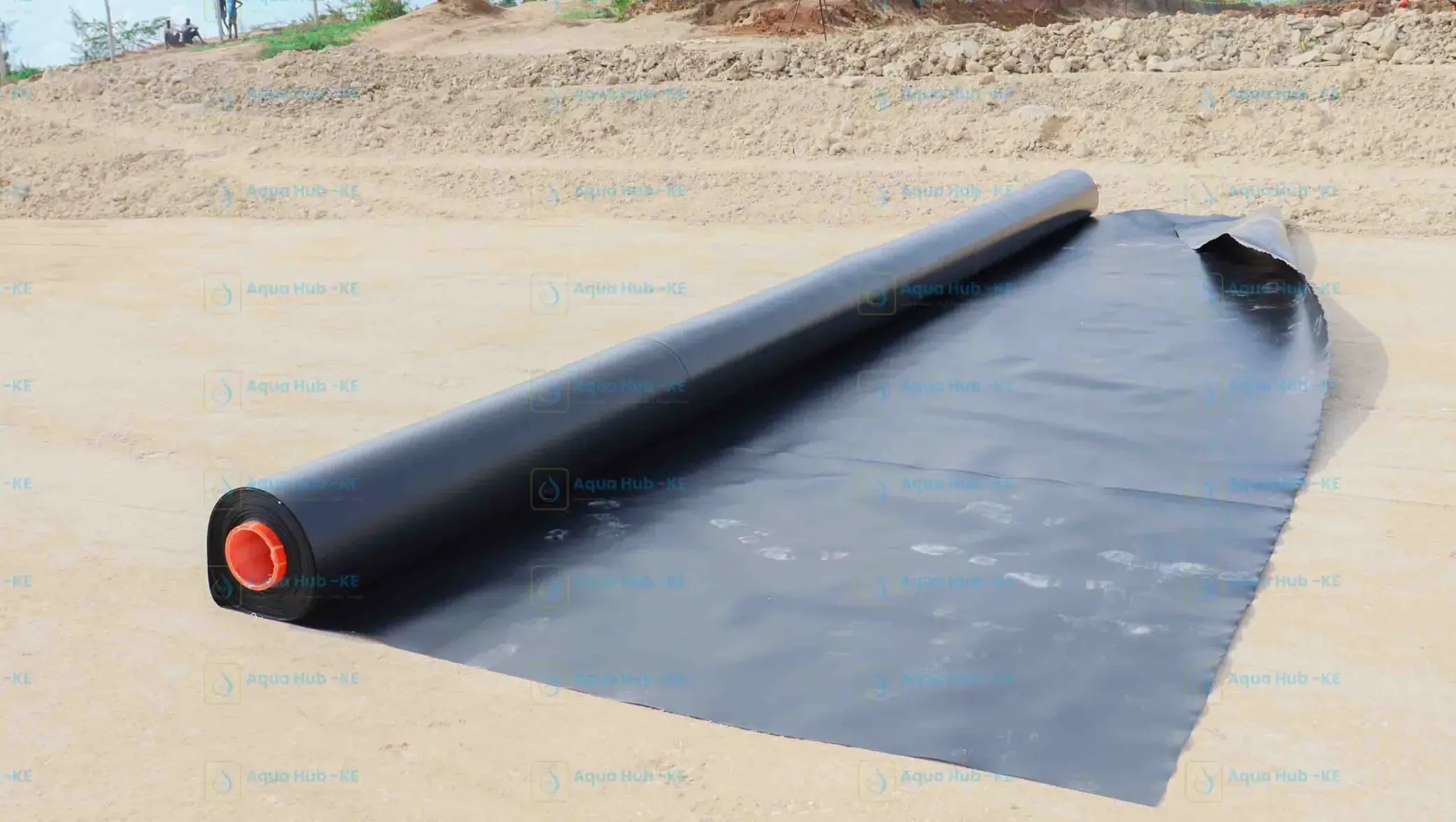
Pond liners for sale in Kenya are based on the thickness size and material of manufacture. At Aqua Hub LTD, we customize fishpond liners to fit the requirements of your fishponds. As often the common fishpond size will affect the number of pond liner rolls to use.
Our fishpond liners are in rolls of 8 m by 50 m wide often with thickness levels of either 0.3mm, 0.5mm, 0.75mm and 1 mm.
Fishpond Liners Specifications
- Gauge or thickness levels – 300-, 550-, 750- and 1000-micron pond liners.
- Long average shelf life of 20- 30 years
- Made of HDPE material with UV additives.
- Tensile of 20 MPa
- Elongation 500 percent.
- 8 m width and 50 m length.
Fishpond Liner Price in Kenya
Our fishpond liner price in Kenya as listed is for every square meter and varies with how thick the liner is.
- 0.3mm thick liner – KES 200
- 0.5 mm liner – KES 230
- 0.75 mm liner – KES 330
- 1 mm thick liner – KES 420
How Fishpond Liners function
Pond liners hold water in place. They stop leaks from porous soil. Kenya’s dry spells make them essential. Farmers in arid areas like Kitui or Kilifi use them for irrigation too. But for fish farming, they are top grade. You rear tilapia in a lined pond. The water stays clean and full. No need to refill every week.
Common Use of Fishpond Liners
Pond liners are utilized in fishponds to stop water level drop by preventing underground seepage. The use of fishpond liners is common in areas with highly porous soils and regions with lower access to water.
What Affects the Efficiency of Fishpond Liners?
UV effect
Think about your setup. You excavate a hole. Line it with plastic. Add water and fingerlings. The liner blocks seepage. It also keeps out weeds and pests from the soil. UV treatment protects it from the sun. Kenya’s intense rays degrade cheap pond liners fast. Good liners last 10 to 50 years.
Soil type
But not all liners work the same. Soil type matters. Sandy ground needs thicker ones. Rocky spots demand puncture resistance. You measure your pond first. Length plus width plus twice the depth. Add extra for overlaps. That gives the size you buy.
Installation
Installation seals the deal. You smooth the base. Lay the liner. Tuck edges into a trench. Cover with soil. Water its in. Done right, it holds for years. Wrong, and leaks start. Pros handle welding seams. Heat fuses sheets together. No gaps.
Fishpond Liner Price: Sizes and Uses
Sizes fit your plan. Small pond: 10×10 meters. Surface 100 square meters. Depth 1.5 meters. Liner needs 13×13 meters. Add for walls. You rear 500 tilapias. Harvest 300 kilos.
Medium: 20×15 meters. 300 square meters. Depth 2 meters. Liner 24×19 meters. Stock 2,000 fish. Use for home and sale.
Large: 50×30 meters. 1,500 square meters. Depth 3 meters. Liner 56×36 meters. Commercial scale. 10,000 fingerlings. Yields tons.
Fishpond Liner Uses
Uses of fishpond liners go beyond fish rearing. They are used to:
- Line irrigation dams.
- Store rain for crops. In Kilifi, farmers harvest coastal runoff. Liner holds it. Pump to maize fields.
- For lining aquaculture tanks too. Concrete bases. Liner seals cracks. Portable ponds on frames. You move them. Liner folds easy.
How to Size Fishpond liner required
Calculate yours. Length + 2x depth. Width + 2x depth. Multiply. Add 10 percent overlap.
For example, a pond liner measuring 15m long by 10m wide, and 1.5m deep, the required pond liner is calculated by:
length = 15m + (2 x 1.5m) + 0.5 m overlap
width = 10m + (2 x 1.5m) + 0.5 m overlap
(15+3) x (10+3) =18.5 x 13.5=250 square meters.
What Affects Fishpond Liner Price in Kenya?
- Thickness: Thicker means more material, stronger, higher cost.
- Material: HDPE liners are costly compared to non-UV treated Pond liners
- Size and roll width: high thickness size cost more to buy than low thickness levels.
- Installation welding required: Though the price per square meter may appear low, if installation is complex then labor cost increases.
Durability and Recommended Uses
| Pond Liner thickness | Durability | Best Use Cases |
| 0.3mm | 10 – 15 years | Light duty applications. For less porous soil. |
| 0.5mm | 15 -20 years | medium sized fish ponds and dams. |
| 0.75mm | 25 -35 years | Medium to large ponds. Also works for concrete tanks. |
| 1 mm | 40 – 50 years | Heavy duty applications. Large ponds, dams and regions with highly permeable soil |
Best Pond | Dam Liners in Kenya
HDPE Pond liners by Aqua Hub LTD stands out among other liner materials because of its durability and resistance. The HDPE fishpond liner materials is non-toxic, less corrosive and smooth thus causing no harm to fish, water or the environment.
What Makes a Good Pond Liner in Kenya?
- UV-treated: East Africa receives high sunlight intensity, and a good liner should work under sunlight exposure.
- Virgin or new material: so, it can last longer and save you on cost of replacement.
- Local support: A supplier based in Kenya means easier delivery, local installation guidance.
- Good thickness and strength for your usage. For fishponds, you might not need the thickest dam liner, but you still want quality.
- Proper seams and installation support: For large liners, welding and seams can be failure points if done poorly.
- Life expectancy and warranty: A liner that is designed to last long will save you money and water bills.
How to Choose the Right Fishpond Liner
Which liner is the ideal one for your pond? You can first determine by calculating the size of the pond liner required. To determine that, you need the measurement of the pond including the overlap.
After you determine the size of the liner that will fit, you still have to select which gauge of the liner it will be. Thickness of a liner is selected as per the soil structure and volume of water the pond holds.
Material of the pond liner also matters. It is always important to choose UV treated HDPE pond liners over other types because of their durability.
You also must think about who to order your pond liners from. Suppliers like Aqua Hub are the industry recognized dealers in top quality dam and pond liners.
Buy Pond Liners Online
Ordering your fishpond liners online is convenient, especially for individuals residing in upcountry or areas far from Nairobi. We often recommend a site visit before any quotation is done for a fishpond liner. However, if you have accurate measurements from your own technician, you can send them and get your dam liner delivered to you.
Call 0790719020
How to Lay and Use Fishpond Liner
1: Define Your Pond Dimensions & Purpose
- How big is your pond (length × width × depth)?
- What is the shape? Are there slopes, shelves, irregular sides?
- Is this purely for fish farming, or multi-purpose (fish + irrigation + water storage)?
- What is your budget?
2: Assess Site Conditions
- What is the soil like? Is it rocky, sandy, full of roots? If lots of rocks/roots, you’ll need a stronger liner and protective underlay.
- Is the site exposed to strong sun/UV? Is there tree cover? UV exposure matters for liner durability.
- Is there risk of animals burrowing or roots penetrating?
- Consider access: how easy is it to deliver large rolls to your site?
3: Choose Material and Thickness
- For fishponds where you want durability: aim for at least 0.5 mm thickness, preferably 0.75 mm or more if budget allows.
- If you have an uneven pond shape or want extra protection, pick a premium material (HDPE virgin).
- If budget is tight but pond is small and non-critical, you could choose a thinner liner (say 0.3mm) but prepare for earlier replacement.
4: Find a Supplier | Order Pond Liners from Aqua Hub
- Choose a supplier in Kenya with good reputation for pond liners. Should have UV treated pond liners and reliable installation.
- Ask for references of previous fishpond installations in Kenya.
5: Purchase and Install the Pond Liner
- Buy fishpond liners and then installation is conducted.
- Installation includes excavation, smoothing base, underlay/padding, edge trenching, seam welding or joiners.
6: Inspect Before fish rearing
- After installation, but before introducing fish fingerlings, inspect for seams, wrinkles, any possible leaks.
- Ensure anchoring is correct, edges are secured to prevent liner from slipping under water pressure.
- If there are any leakages, repair the section of the liner using hot welding blower.
Fishpond Liner Recommendation Based on Use
- For large agricultural water pans/fishponds: Use UV treated HDPE liner 0.75mm or 1mm.
- For medium size fishponds: Use a reliable liner with fish safe rating, decent thickness greater than 0.5mm.
- For decorative ponds: You may use a lower thickness liner if cost is a concern but still ensure quality, so you don’t experience leaks or punctures.
How to Maintain your Pond Liner
- Regularly inspect liner for damage (roots, animals, UV cracks).
- Remove debris or sharp objects that could puncture.
- Ensure you don’t place heavy boulders or blocking points without protection beneath liner.
Where to Buy Fishpond Liner in Kenya
Aqua Hub LTD
Case Study of Dam Liner Installation in Kilifi
A farmer based in Kilifi Kenya wanted to convert an existing water pan into a dual-use dam: primarily for irrigation water storage during the dry season and secondarily for tilapia fish rearing. The site area for liners was roughly 30 m × 20 m with an average depth of 2 m. The soil was sandy with underlying rocky structure.
After consultation with our technicians, the farmer opted to use a 0.75 mm HDPE liner. Our team went ahead and conducted installation of the pond liner
How we Installed the Pond Liner
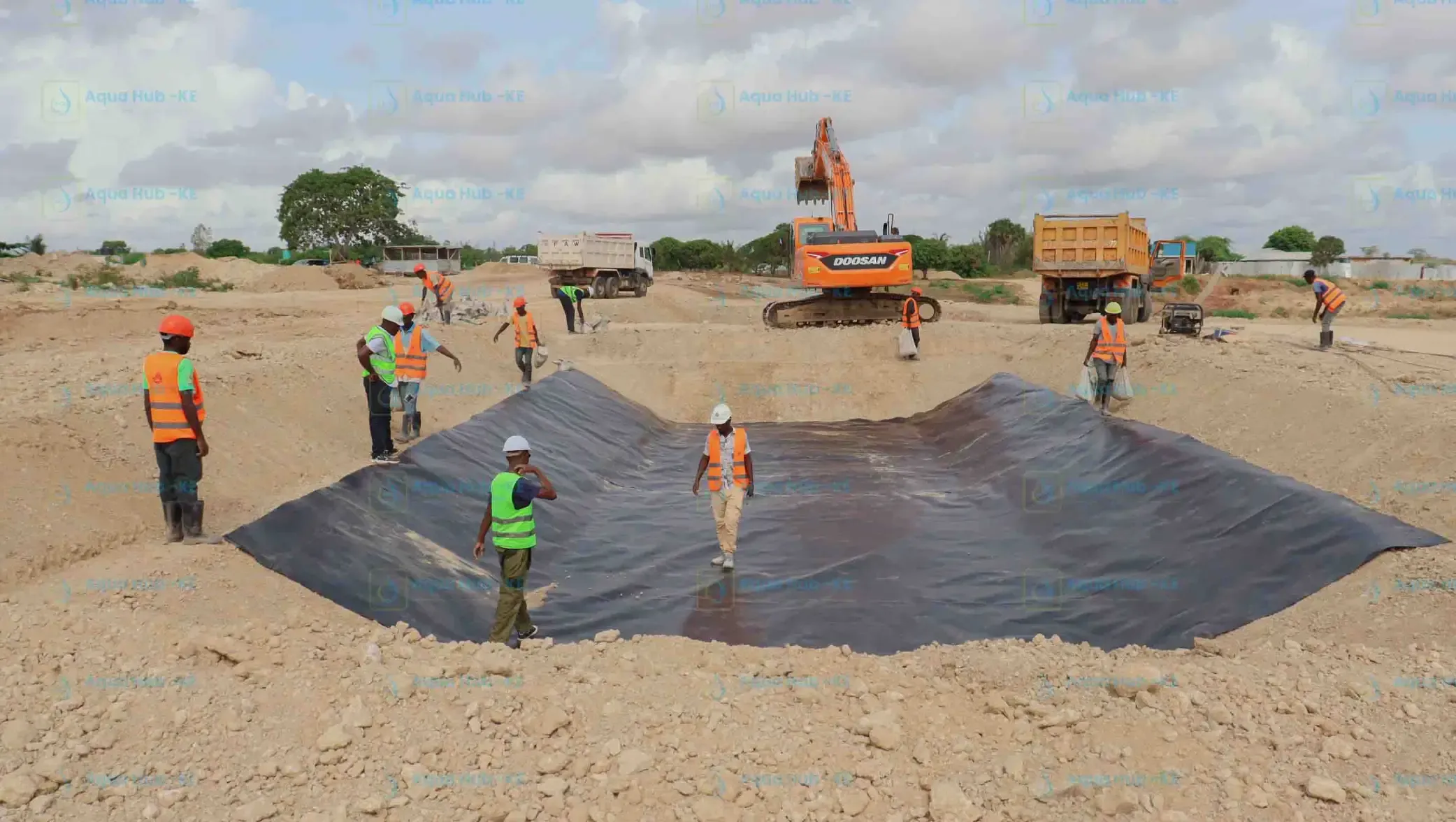
- We excavated the site to shape, cut the slopes and removed roots and rocks from the side walls.
- We used a 50mm layer of sand at the base to smoothen.
- Liner roll was unrolled, trimmed to shape, anchored by trenching around the perimeter (edge trench ~0.5 m deep).
- Seam welding done where two rolls joined (since roll width was 8 m and site width was 20 m, required multiple panels).
- Water slowly filled and was monitored after 48 hours for any signs of seepage. Edge rock placement to protect liner edges and anchors.
- Fish stocking after water quality checked, aeration and water circulation installed.
Outcome & Lessons Learned
- The liner held water with minimal seepage; the farmer reported stable water levels and fish growth over the dry season.
- The upfront cost was significant, but the value showed in the reliability of water supply and reduced losses.
- The farmer recommended that anyone doing similar work budget for proper installation and underlay it’s not just the liner cost but the preparation.
- The installation timeline took 10 days from excavation to pond liner installation, including downtime for inspection and settlement.
Key Takeaways
- When planning a pond or dam liner in Kenya, realistically budget for material and installation.
- Don’t skimp on underlay or ignore the base preparation that are critical for long life.
- Choose material suited to your site conditions (soil, sun exposure, purpose).
- Insist on a reputable supplier and installation team.
- After installation, monitor carefully for leaks in the first few days.
Frequently Asked Questions
1. Where are fishpond liners sold in Kenya?
Aqua Hub LTD
2. How much does it cost to install a fishpond liner on your pond?
KES 100 per square meter for installation, plus liner cost. A 200-square-meter pond totals KES 20,000 to install.
3. Why are fishpond liners black?
Black color stops algae growth, and absorbs heat to warm water
4. Do I really need a fishpond liner for a backyard pond?
Yes, if your soil leaks. It holds water and protects fish
5. Which type of pond liner is best?
HDPE. It resists UV, punctures, and lasts longest.
6. How long does a fishpond liner last?
10 to 30 years, based on thickness and UV treatment.
7. What is the cheapest way to waterproof a pond?
Using a 0.5 mm HDPE Pond liner
8. How is a fishpond liner installed?
- Clear rocks.
- Smooth base.
- Unroll liner.
- Weld seams.
- Tuck edges in trench.
- Cover with soil
9. Where are fishpond liners sold in Kenya?
Aqua Hub Kenya


